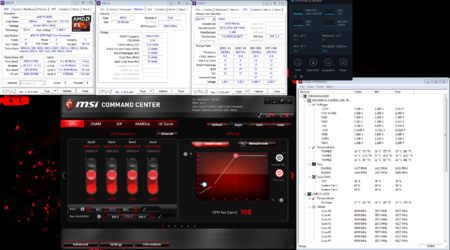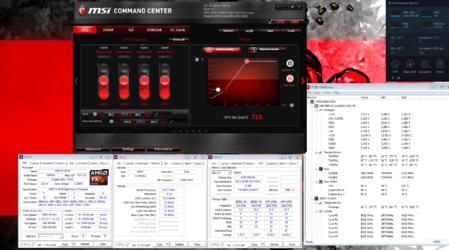Jhecker1020
New Member
- Joined
- Sep 4, 2015
Okay so first and foremost, here the build specs relevant to this issue:
-MSI 990FXA-Gaming
-AMD FX-8370
-Gamer Storm DEEPCOOL 360mm AIO w/ 6 PWM fans in Push/Pull venting out the top of my HAF936
-4 x 8gb G. Skill Trident 2400
-Samsung 840 EVO SSD 250gb
-750w Rosewill Hive PSU
Now, on to the problem.
My Mobo is rated for a maximum 32gb of 2133. Normally I would have purchased 2133 for this build, but I already had the 2400 from a previous APU build I did.
So I put everything together, installed OS, all current drivers (including updated Mobo BIOS), and booted up (leaving all bios settings at default, which read the RAM as 1333)
Once I established the system was stable, I went back into BIOS and manually set the RAM to 2133, set timings to manufacturer specs, and set voltage to man. spec of 1.65v.

After rebooting, everything appeared stable, except I noticed something strange - my system monitor only showed 22- or 23-point-something gb of RAM available, whereas at default it showed all 32ish.
Foolishly, I didn't think anything of it, so I booted up Prime95 to get a system baseline before starting to OC.
Now, with everything except the RAM at stock, here's what happened:
-Small FFT runs stable for a couple minutes then complete system freeze. Have to do a hard reset.
-Large FFT runs for about 10 seconds before all workers fail one after the other
-Blend runs for about .3 nanoseconds before all workers fail.
Well, that's gotta be RAM, right? So on to MEMTEST86+. I keep all RAM settings as they are, boot up MEMTEST, and go run errands. 2+ hours later I get home to the below results:

So I have two main concerns from these results.
The first is obviously the errors. The first 101 of the errors are all from Test#5, with the last two being from Test #7.
The other concern is how MEMTEST reads my RAM settings. DDR2, really?!
After seeing these results, I go back into BIOS, step the clock speed down to 1866 and leave voltage and timing the same (even though in theory I should be able to tighten up the timing significantly at that much lower of clock speeds, but that's a matter for another time)
Now not only does my system actually show all 32gb of RAM being available, but 6ish hours of MEMTEST (that's how long it took for one complete Pass of all tests for all 32gb), yielded no errors. Hell, Windows Memory Utility even passed 100%, for what that's worth. It is worth noting however, that MEMTEST still showed the same DDR stats and timings that it did when clocked at 2133.
So I rerun Prime95, (still with default/stock settings for everything except RAM) and all three tests run perfectly fine for at least 30 minutes each. Being the impatient jack@ss I am, I decide that's good enough to try some mild OC.
I disable any and all power saving/throttling features in BIOS (AMD CnQ, C6, Turbo Core, etc.) and set clock to 4400mhz at 1.432v (CPU-Z showed stock voltage at like 1.36v). I know I should be able to run that speed with much lower voltage no problem, but my AIO actually cools very well, and I'm more interested in seeing if my "stable" RAM can support the OC, without having to worry about cores failing from low voltage.
So I set up CPU-Z, HWMonitor, and MSI Command Center (to monitor fans), and boot up Prime95. All three tests run for 30min+ with no errors. Now it's about 2AM and I have to be up at 8, so I decide to let Small FFT run for that duration. I set everything up ,and head to bed. Last I saw it had been running for about 20 min with no issues.
Being the idiot I am, I forgot to disable the screen saver
So when I woke up, both screens were black (system froze on screen saver) and required a hard reset. As such, I had no way of telling how long the test ran before the system froze.
The fact it froze, however, tells me the ram failed yet again.
Oh, and one other thing: at the current 1866 speeds, my Mobo reads all 4 DIMM as follows:

At this point I'm thinking I have at least 1 bad stick. I'm *REALLY* hoping to avoid having to test each stick individually, but I'm afraid that's my only real next step.
So... anyone have a thought?
-MSI 990FXA-Gaming
-AMD FX-8370
-Gamer Storm DEEPCOOL 360mm AIO w/ 6 PWM fans in Push/Pull venting out the top of my HAF936
-4 x 8gb G. Skill Trident 2400
-Samsung 840 EVO SSD 250gb
-750w Rosewill Hive PSU
Now, on to the problem.
My Mobo is rated for a maximum 32gb of 2133. Normally I would have purchased 2133 for this build, but I already had the 2400 from a previous APU build I did.
So I put everything together, installed OS, all current drivers (including updated Mobo BIOS), and booted up (leaving all bios settings at default, which read the RAM as 1333)
Once I established the system was stable, I went back into BIOS and manually set the RAM to 2133, set timings to manufacturer specs, and set voltage to man. spec of 1.65v.
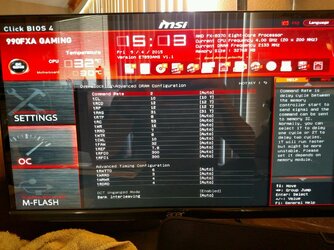
After rebooting, everything appeared stable, except I noticed something strange - my system monitor only showed 22- or 23-point-something gb of RAM available, whereas at default it showed all 32ish.
Foolishly, I didn't think anything of it, so I booted up Prime95 to get a system baseline before starting to OC.
Now, with everything except the RAM at stock, here's what happened:
-Small FFT runs stable for a couple minutes then complete system freeze. Have to do a hard reset.
-Large FFT runs for about 10 seconds before all workers fail one after the other
-Blend runs for about .3 nanoseconds before all workers fail.
Well, that's gotta be RAM, right? So on to MEMTEST86+. I keep all RAM settings as they are, boot up MEMTEST, and go run errands. 2+ hours later I get home to the below results:
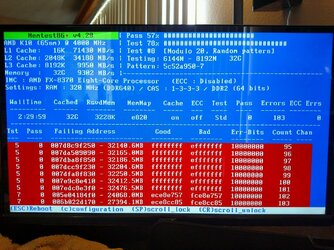
So I have two main concerns from these results.
The first is obviously the errors. The first 101 of the errors are all from Test#5, with the last two being from Test #7.
The other concern is how MEMTEST reads my RAM settings. DDR2, really?!
After seeing these results, I go back into BIOS, step the clock speed down to 1866 and leave voltage and timing the same (even though in theory I should be able to tighten up the timing significantly at that much lower of clock speeds, but that's a matter for another time)
Now not only does my system actually show all 32gb of RAM being available, but 6ish hours of MEMTEST (that's how long it took for one complete Pass of all tests for all 32gb), yielded no errors. Hell, Windows Memory Utility even passed 100%, for what that's worth. It is worth noting however, that MEMTEST still showed the same DDR stats and timings that it did when clocked at 2133.
So I rerun Prime95, (still with default/stock settings for everything except RAM) and all three tests run perfectly fine for at least 30 minutes each. Being the impatient jack@ss I am, I decide that's good enough to try some mild OC.
I disable any and all power saving/throttling features in BIOS (AMD CnQ, C6, Turbo Core, etc.) and set clock to 4400mhz at 1.432v (CPU-Z showed stock voltage at like 1.36v). I know I should be able to run that speed with much lower voltage no problem, but my AIO actually cools very well, and I'm more interested in seeing if my "stable" RAM can support the OC, without having to worry about cores failing from low voltage.
So I set up CPU-Z, HWMonitor, and MSI Command Center (to monitor fans), and boot up Prime95. All three tests run for 30min+ with no errors. Now it's about 2AM and I have to be up at 8, so I decide to let Small FFT run for that duration. I set everything up ,and head to bed. Last I saw it had been running for about 20 min with no issues.
Being the idiot I am, I forgot to disable the screen saver

So when I woke up, both screens were black (system froze on screen saver) and required a hard reset. As such, I had no way of telling how long the test ran before the system froze.
The fact it froze, however, tells me the ram failed yet again.
Oh, and one other thing: at the current 1866 speeds, my Mobo reads all 4 DIMM as follows:
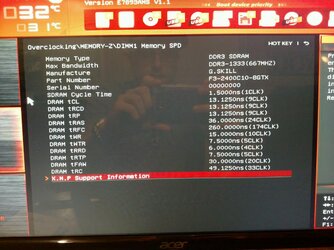
At this point I'm thinking I have at least 1 bad stick. I'm *REALLY* hoping to avoid having to test each stick individually, but I'm afraid that's my only real next step.
So... anyone have a thought?
